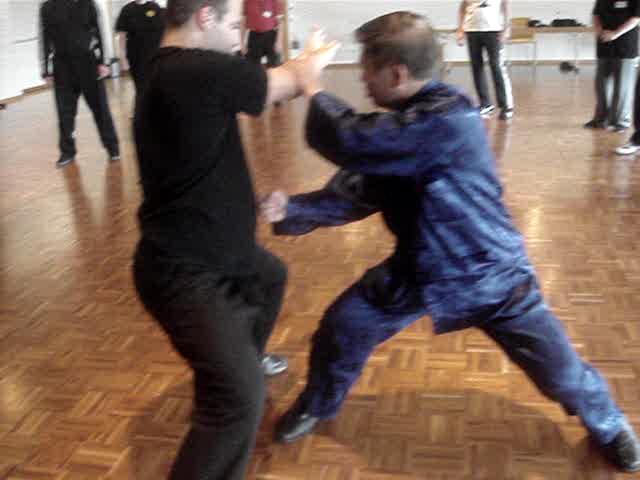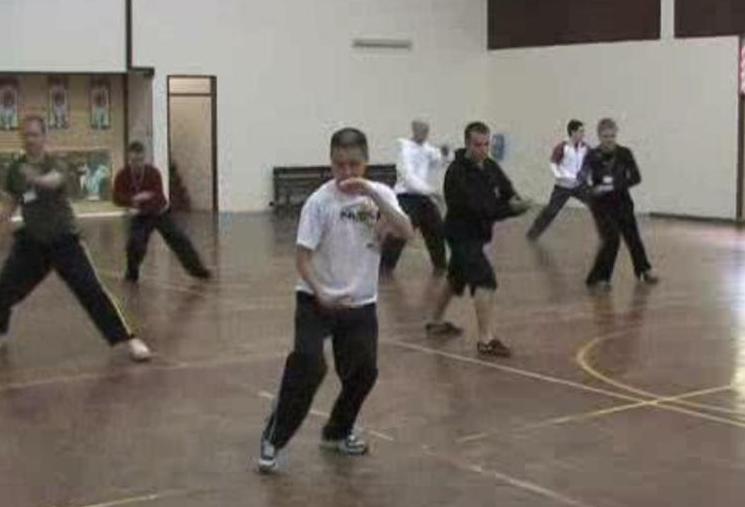CAN WE PRACTICE IRON-WIRE AND WUDANG TAIJIQUAN AT THE SAME TIME?

Grandmaster Wong applies a pattern from Wudang Taijiquan, "Tortoise and Snake in Combat", to counter Sifu Roland's attack.
Can we practice Iron-Wire and Wudang Taijiquan at the same time?
At the Special Shaolin-Taijiquan Course in Sabah from 12th to 18th October 2011, Sifu Eugene Siterman of USA asked the above question, which will be posted in the Question-Answer Series. But as there is a long waiting list, it will only appear around July next year (2012). Grandmaster Wong reveals it earlier here as he believes many students will be interested in the answer.
For moat people, practicing Iron-Wire and Wudang Taijiquan at the same time would negate the results of both arts. Suppose a student practices only Iron-Wire, he gets 100 units of benefit. If he practices only Wudang Taijiquan, he also gets 100 units of benefit.
If he spends half the time practicing Iron-Wire and the other half practicing Wudang Taijiquan, will he get 50 units of benefit from Iron-Wire, and 50 units from Wudang Taijiquan? No, he will get only 35 units each, so that his total benefit is 70 units instead of 100 units had he practiced only one art. This is the main reason why masters advice their students to focus on one art at a time.
But this does not apply to us in Shaolin Wahnam. For us, if we practice Iron-Wire and Wudang Taijiquan we get more benefit than just practicing any one of them. For example, if a Shaolin Wahnam student practices only Iron-Wire, he gets 100 units of benefits. If he practices only Wudang Taijiquan, he also gets 100 units of benefit.
But if he sends half the time practicing Iron-Wire and the other half practicing Wudang Taijiquan, he will get not just 50 units of benefit, but 65 units of benefit for each art, making a total benefit of 130 units, not just 100 units had he practiced only one art.
Why is it that if other people practice Iron-Wire and Wudang Taijiquan, or any two opposing arts, at the same time, they get less benefit than practicing just any one of them, whereas for us in Shaolin Wahanm if we practice Iron-Wire and Wudang Taijiquan, or any two opposing arts, at the same time, we get more benefit than practicing just any one of them?
It is because for other people the two arts contradict each other and therefore the results are minimized, whereas for us the two arts complement each other and therefore the results are maximized.
To develop internal force in Iron-Wire training, a practitioner has to consolidate his chi, or energy. To develop internal force in Wudang Taijiquan, a practitioner has to let his chi flow.
If he focuses on just Iron-Wire or just Wudang Taijiquan, he can continue consolidating chi to develop internal force in Iron-Wire, or he can continue letting his chi flow to develop internal force in Wudang Taijiquan. However, if he practices Iron-Wire and Wudang Taijiquan at the same time, the processes of consolidating chi and of letting chi flow will contradict each other, reducing his benefit.
For us the case is different. It is because we have the magical skill of transforming chi flow into consolidating chi, and vice versa. Hence, when we practice Iron-Wire, we consolidate our chi. But we can also let this consolidated chi to flow if we wish.
So when we change to practicing Wudang Taijiquan, we do not start from stretch because we already have the consolidated chi developed earlier in Iron-Wire training. We can convert this consolidated chi to flowing chi. Similarly when we change to practicing Iron-Wire again, we can convert the flowing chi developed earlier in Wudang Taijiquan to consolidated chi.

Course participants performing the Iron-Wire Set in Finland in January 2010
An analogy may make this clear. If a worker spends some of his income, he has less money to save in his bank. If he saves more money in his bank, he has less money to spend.
For an entrepreneur the case is different. He can use some of his savings to generate more income so that he has more money to spend. As he has more income he can also increase his saving.
For an entrepreneur, both his saving and his expenditure grow because he can convert one to another. The more he saves, the more he can spend. The more he spends, i.e. uses his cash flow, the bigger will be his bank account.
A worker can't do this because his income is fixed. The more he saves, the less he spends, and vice versa.
For us, both our consolidated chi and flowing chi grow because we can convert one to another. The more we consolidate our chi, the more is our flowing chi. The more our chi flows, the more we can consolidate our chi.
Other people cannot do this. The more they consolidate their chi, the less is their chi flow. The more their chi flows, the less is their consolidated chi.
The analogy becomes clearer if we quantify our examples. If a worker has 500 euros in his bank and uses 200 of it, the balance in his account is 300. The next month when he saves another 500, his total is 800 euros.
If an entrepreneur has 500 euros in his bank, and uses 200 to generate more income, this 200 becomes 300 which he can put back in his bank, making the balance of 600. The next month when he saves another 500, his total is 1100 euros.
If other people have consolidated 500 units of energy in their Iron-Wire training, and then use 200 units of it in Wudang Taijiquan, their balance is 300 units of energy. This is evident in their becoming tired after the training. In the next training session when they consolidate another 500 units of energy from Iron-Wire, their total energy is 800 unites, not 1000 unites. Hence, they minimize their result if they practice Iron-Wire and Wudang Taijiquan at the same time.
If we have consolidated 500 units of energy in our Iron-Wire training, and then uses 200 units of it in Wudang Taijiquan, our total amount is still 500 units, not 300 units because our energy flows, not drained away. This is evident in our not becoming tired in our training.
Meanwhile the 200 units of flowing energy in Wudang Taijiquan training becomes 300 units, with an increas of 100 units, because we can generate more energy with it. When we convert this 300 units into consolidated energy and add it to the original 300 units, it becokes 600 units of consolidated energy. This is evident in us becoming more energetic after the training. In the next training session when we consolidate another 500 units of energy from Iron-Wire, our total energy is 1100 units, not 1000 units. Hence, we maximize our result when we practice Iron-Wire and Wudang Taijiquan at the same time.
20th October 2011, Sungai Petani.

Sifu Eugene and other participants performing Wudang Taijiquan at the Special Shaolin-Taijiquan Course in sabah in October 2011
